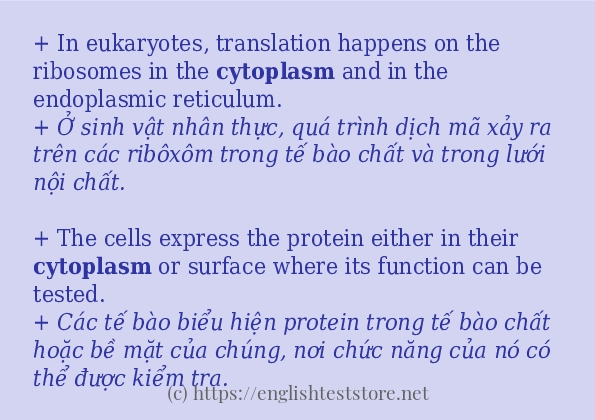Các cách sử dụng từ “cytoplasm”:
+ In eukaryotes, translation happens on the ribosomes in the cytoplasm and in the endoplasmic reticulum.
+ Ở sinh vật nhân thực, quá trình dịch mã xảy ra trên các ribôxôm trong tế bào chất và trong lưới nội chất.
+ The cells express the protein either in their cytoplasm or surface where its function can be tested.
+ Các tế bào biểu hiện protein trong tế bào chất hoặc bề mặt của chúng, nơi chức năng của nó có thể được kiểm tra.
+ The main function of the cytoplasm is to hold the organelles in place.
+ Chức năng chính của tế bào chất là giữ các bào quan tại chỗ.
+ They are cells that possess a large smooth nucleus, a large area of cytoplasm and many internal vesicles for processing foreign material.
+ Chúng là những tế bào sở hữu một nhân trơn lớn, một diện tích lớn của tế bào chất và nhiều túi bên trong để xử lý vật chất lạ.
+ In all cells, the cell membrane separates the cytoplasm inside the cell from its surroundings.
+ Trong tất cả các tế bào, màng tế bào ngăn cách tế bào chất bên trong tế bào với môi trường xung quanh.
+ In RNA, which is used in the cytoplasm for protein synthesis, adenine sticks to uracil.
+ Trong RNA, được sử dụng trong tế bào chất để tổng hợp protein, adenine dính vào uracil.
+ The cytoplasm is highly structured: it is not some kind of soup, even though it is made out of 7580% water.
+ Tế bào chất có cấu trúc cao: nó không phải là một loại súp nào đó, mặc dù nó được tạo ra từ 7580% nước.

Các câu ví dụ cách dùng từ “cytoplasm”:
+ When the cytoplasm and organelles are divided evenly between the two new cells, the plate then becomes less flimsy and soon becomes another cell wall separating the daughter cells.
+ Khi tế bào chất và các bào quan được phân chia đồng đều giữa hai tế bào mới, tấm này sau đó trở nên ít mỏng manh hơn và nhanh chóng trở thành một thành tế bào khác ngăn cách các tế bào con.
+ Then the mRNA moves from the nucleus to the ribosomes in the cytoplasm to form proteins.
+ Sau đó mRNA di chuyển từ nhân đến các ribosome trong tế bào chất để tạo thành protein.
+ Eventually, the hydrogen flows back into the cytoplasm of the mitochondria through protein channels.
+ Cuối cùng, hydro chảy trở lại tế bào chất của ti thể thông qua các kênh protein.
+ In a skilfully made H E preparation the red blood cells are almost orange, and collagen and cytoplasm go different shades of pink.
+ Trong quá trình chuẩn bị HE một cách khéo léo, các tế bào hồng cầu gần như có màu cam, còn collagen và tế bào chất chuyển sang các màu hồng khác nhau.
+ However, this is rather misleading because the cytoplasm is full of structures called organelles, which do various tasks.
+ Tuy nhiên, điều này khá sai lầm vì tế bào chất có đầy đủ các cấu trúc được gọi là bào quan, làm nhiều nhiệm vụ khác nhau.
+ Some chemical messengers, such as testosterone, can pass through the cell membrane, and bind directly to receptors in the cytoplasm or nucleus.
+ Một số sứ giả hóa học, chẳng hạn như testosterone, có thể đi qua màng tế bào và liên kết trực tiếp với các thụ thể trong tế bào chất hoặc nhân.
+ These cells contain a flagellum, which is surrounded by a collar of cytoplasm at its base.
+ Các tế bào này chứa một trùng roi, được bao quanh bởi một vòng cổ của tế bào chất ở gốc của nó.
+ When the cytoplasm and organelles are divided evenly between the two new cells, the plate then becomes less flimsy and soon becomes another cell wall separating the daughter cells. + Khi tế bào chất và các bào quan được phân chia đồng đều giữa hai tế bào mới, tấm này sau đó trở nên ít mỏng manh hơn và nhanh chóng trở thành một thành tế bào khác ngăn cách các tế bào con.
+ Then the mRNA moves from the nucleus to the ribosomes in the cytoplasm to form proteins. + Sau đó mRNA di chuyển từ nhân đến các ribosome trong tế bào chất để tạo thành protein.
+ Then the mRNA moves from the nucleus to the ribosomes in the cytoplasm to form proteins. + Sau đó mRNA di chuyển từ nhân đến các ribosome trong tế bào chất để tạo thành protein.
+ After being produced in the nucleolus, ribosomes are exported to the cytoplasm where they translate mRNA into proteins.
+ Sau khi được tạo ra trong nucleolus, ribosome được xuất sang tế bào chất, nơi chúng dịch mRNA thành protein.
+ The cytoplasm does not contain plastids.
+ Tế bào chất không chứa plastids.
+ They have evolved mechanisms which pump protons out of the intracellular space in order to keep the cytoplasm at or near neutral pH.
+ Chúng đã phát triển các cơ chế bơm proton ra khỏi không gian nội bào để giữ cho tế bào chất ở hoặc gần pH trung tính.
+ In glycolysis, glucose in the cytoplasm is broken into two molecules of pyruvate.
+ Trong quá trình đường phân, glucose trong tế bào chất bị phá vỡ thành hai phân tử pyruvate.
+ Small granules in their cytoplasm contain proteins and enzymes called granzymes.
+ Các hạt nhỏ trong tế bào chất của chúng có chứa các protein và enzym được gọi là granzyme.
